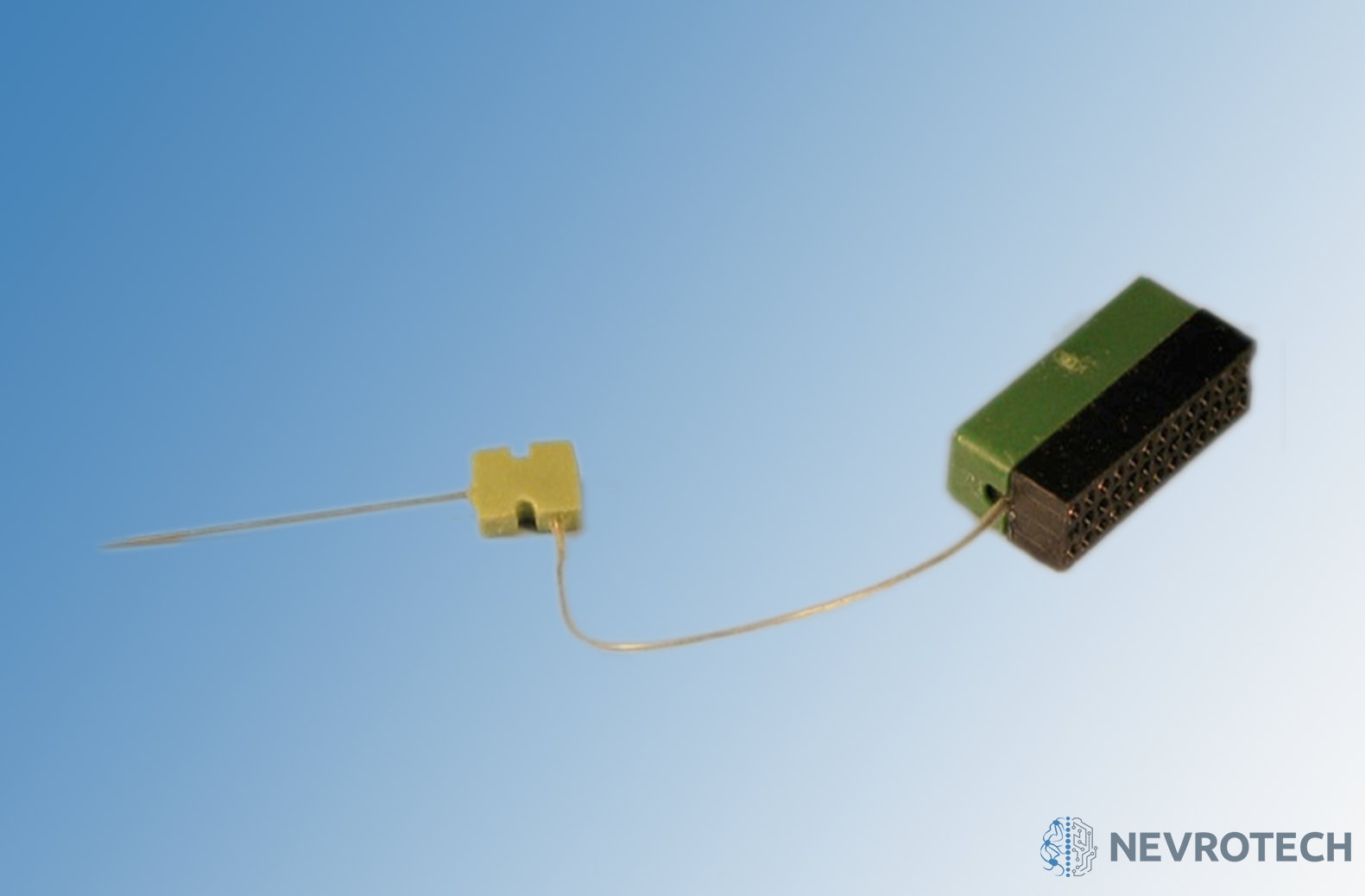Chronic Laminar Probes have multiple recording sites in a configuration up to 32 electrode channels. They come with either a conical or sharpened tip, from which the latter has the benefit of easy dural penetration.
Chronic Laminar Probes - CLP
These probes are designed for chronic application in medium to large subjects, such as primates and they are available in linear, stereotrode or tetrode configurations. Chronic Laminar Probes have an exceptionally durable structure that is also highly customizable.
The recording sites are placed on the side of a symmetric, stainless steel/epoxy cone with a choice of 4, 8, 16, 24 or 32 electrode channels in a length up to 150mm. These Platinum/Iridium recording sites are available in 15, 20, 25 and 40μm diameter options. The smallest diameter of 15μm allows effective single-unit recording, and complemented with low impedance such probes have a better signal-to-noise ratio (SNR). Larger diameter probes are more suitable for field potential recordings.
Chronic Laminar Probes have multiple recording sites in a configuration up to 32 electrode channels. They come with either a conical or sharpened tip, from which the latter has the benefit of easy dural penetration.
These probes are designed for chronic application in medium to large subjects, such as primates and they are available in linear, stereotrode or tetrode configurations. Chronic Laminar Probes have an exceptionally durable structure that is also highly customizable.
The recording sites are placed on the side of a symmetric, stainless steel/epoxy cone with a choice of 4, 8, 16, 24 or 32 electrode channels in a length up to 150mm. These Platinum/Iridium recording sites are available in 15, 20, 25 and 40μm diameter options. The smallest diameter of 15μm allows effective single-unit recording, and complemented with low impedance such probes have a better signal-to-noise ratio (SNR). Larger diameter probes are more suitable for field potential recordings.
The silicone output lead connects the probe to the connector, which flexibility allows the movement of the probe into different positions while in use. The connecting part between the probe and the silicone cable is araldite-type epoxy resin. Chronic Laminar Probes allow either superficial or deep brain penetration.
Multiple connector types are available for providing easy connection to your data acquisition system. It may also be possible to produce these probes beyond the listed parameters to accommodate the most ideal configuration for your research needs.
- Highly robust and reusable stainless steel/epoxy construction
- Single, stereotrode or tetrode configurations available
- Chronic recordings in medium to large animals
- Highly customizable design
- Conical tip to minimize trauma
- Dura puncture
- Platinum/Iridium sites (4-32 channels)
- Various connector types available
GENERAL
| Ideal method of use | Chronic |
| Application method | In vivo |
| Research phase | Pre-clinical |
| Subject | Mid- and large-sized animals, such as primates |
| Shape | Conical, symmetric probe |
| Linear | Y |
| Steretrode | Y |
| Tetrode | Y |
| Spacing if stereotrode or tetrode (µm) | Min. 50 |
TIP
| Angle (°) | 15, 30, 60 |
| Material | Epoxy, (Stainless Steel) |
| Shape | Tapered (conical or sharpened) |
SHAFT
| Material | Stainless Steel |
| Diameter (µm) | 185-360 (varies based on the number of electrodes) |
| Length (mm) | 10-150 (tip to the end of shaft) |
| Ferromagnetic | Y (non-MRI compatible) |
ELECTRODE SITES
| Material | Platinum/Iridium |
| Diameter (µm) | 15, 20, 25, 40 |
| Inter-electrode spacing (µm) | 50-500 (100 is typical) |
| Number of electrode channels | 4, 8, 16, 24, 32 |
| Tip to 1st site distance (µm) | 500-800 (combination of tip angle and probe diameter) |
CAPILLARY FLUID CHANNEL
| Applicable | N |
| Material | – |
| Outer diameter (µm) | – |
| Inner diameter (µm) | – |
FIBRE OPTICS
| Applicable | N |
| Diameter (µm) | – |
REINFORCEMENT TUBE
| Applicable | N |
| Diameter (µm) | – |
| Length (mm) | – |
SILICONE DISK
| Silicone disk | N |
| Diameter (mm) | – |
| Thickness (mm) | – |
OTHER
| Connector types | Omnetics, Precidip (as per user’s request) |
| Lifespan | Recording from 1 subject |
| Silicone cable between connector and probe (mm) | 10-200 |
| Special notes | – |
You may find downloadable content under Resources:
- Grand, B. Dombovari, E. Boldizsar, G. Karmos, I. Ulbert, “Cortical Gating of Auditory Information Processing in Sleep,“ FENS Forum Abstracts, 8-12 July 2006; 3:A073.6
- Ulbert, R. Csercsa, L. Grand, E. Boldizsár, A. Magony, B. Dombovári, G. Karmos, ”Evoked ‘up’ states in the cat auditory cortex,” FENS Forum Abstracts, 8-12 July 2006; 3:A073.019
- Ulbert, L. Grand, B. Dombovári, R. Csercsa, A. Magony, E. Boldizsár, G. Karmos, ”Evoked cortical hyperpolarization controls auditory information processing in natural non-REM sleep,” SFN Conference, 14-18 Oct 2006; 239.231/G23
- Dombovári, L. Grand, L. Wittner, G. Karmos, I. Ulbert, ”Comparison of auditory information processing in sleep and anesthesia,” IBRO workshop, 24-26 Jan 2008; P85
- Grand, B. Dombovari, R. Csercsa, L. Wittner, A. Magony, G. Karmos, I. Ulbert, ”Cortical gating of auditory information processing in sleep,” Codybs Workshop, 21-25 June 2009
- Fiáth, D. Horváth, L. Grand, L. Wittner, B. Dombóvári, G. Karmos, I. Ulbert, and R. Csercsa, “Laminar distribution of the spontaneous multiunit activity in the cat auditory cortex during slow wave sleep,” IBRO workshop (Pecs, Hungary), pp. P4-10, 21-23 Jan 2010
- L. Grand 2010, “Development, testing and application of laminar multielectrodes and biocompatible coatings for intracortical applications,“ Ph.D. dissertation, Pazmany Peter Catholic University, Budapest HU
